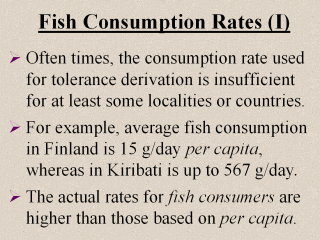 |
Tolerance residue
limits are often considered as inadequate for human health protection when
adopted at their face values. Underlying this allegation is the fact that
the consumption rate used for tolerance derivation is often insufficient for
at least some localities. For example, average fish consumption rates
reported by Gillett and Lightfoot (2002) were up to 567 g/day per capita
for people in Kiribati, which is 38 times greater than that (15 g/day)
reported by Nylander (2004) for people in Finland. The average per capita
rate for Pacific Island countries is around 200 g/day (Gillet and Lightfoot,
2002), whereas the worldwide average is close to 44 g/day (FAO, 2004). Note
that by definition the fish intake for consumers in a locality will
be greater than that locality’s per capita rate. |
